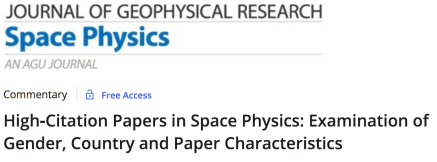Mark Moldwin and I recently published a Commentary on, well, hopefully the title says it all: High-citation papers in space physics: Examination of gender, country, and paper characteristics. He obtained the article information for every paper published in JGR Space Physics in the year 2012, including the citation count as of June 2016 for each paper, and then classified the papers according to, you guessed it, gender, country, and paper characteristics. There were 705 papers in the journal that year, so this task took quite a while to complete, plus we took some time discussing which parameters to even classify for later use. We then analyzed these results to see which qualities about the paper had a statistically significant connection to citation count. A fairly recent year was deliberately chosen to investigate the factors related to citations early in a paper’s lifespan, a time interval of relevance to the calculation of the Journal Impact Factor. As of today, it is still “in press,” so just the accepted version is online, but the paper is Open Access so it is free to read the full text.

Here are the major findings. These qualities of the paper are correlated with more citations in the first few years after publication:
- More coauthors
- More institutions in the author affiliations
- More countries in the author affiliations
- More references in the paper
- A colon in the title
These qualities of the paper had no significant correlation with citations:
- Gender of the first author
- Number of words in the title
- Acronyms in the title
- Geophysical region names in the title
Keep in mind that the standard deviations are wide, so these findings are not necessarily true when comparing any two papers from the “high” and “low” classes. Welch’s t-test statistic uses the standard deviation of the mean, which is a much smaller number than standard deviation (the spread for any one data point in the set), Any individual paper, regardless of its characteristics, could have a high or low citation count a few years after publication. That is, we did not find a “magic parameter” that clearly identifies what will make a paper get many citations, nor one that easily picks out the low-citation papers.
Furthermore, the underlying distribution of values is not Gaussian – but any subset we considered, there is a long, positive tail creating a non-negligible skew to the histogram – yet the probabilities for significance that we used are based on a normal distribution for the two populations. This is why we used a 99% “highly significant” threshold to determine those qualities that are connected to citations.
So, take all of these findings with a grain of salt. Nevertheless, we think the results are interesting for the space physics community to know. The main conclusions that more authors, institutions, countries, and references increases eventual citations are not particularly surprising, but this is the first time it’s been quantified for papers in the field of space physics.
Two results are surprising to us. The first is that there is not a statistical difference in the citation of papers based on the gender of the first author. Other studies have found such bias in other fields, including in other closely related natural sciences, like astronomy. Unlike those studies of other fields, we did not find a statistically significant difference in citations to JGR Space Physics papers based on that parameter.
We did not expect to find any “title parameters” to be connected with citations and most were not. We were rather amused, however, to find that a colon in the title is linked to higher citations. About 20% of the papers that year had a colon in the title. That’s over 100 papers so this is a decently large sample size. We have guesses but, really, we have no good explanation for this. For those wondering, yes, this finding did indeed influence the title of our paper.
In summary, our advice to potential authors of manuscripts for JGR Space Physics is this: collaborate with others and cite the literature. It’s not a guarantee that your paper will receive above-average citations but, based on our analysis, it might help. Happy writing!

Pingback: Even More Year-End Stats for 2018 | Notes from the JGR-Space Physics Editor-in-Chief